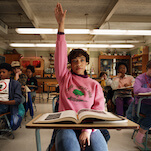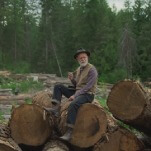With this opening chapter, Simonson delivers an intriguing story about badass warriors in a dystopian fantasy environment, but the writing isn’t the real show here. The dynamic cover image is just a taste of the gorgeous fantasy visuals within, and the showdown between Thor and Jörmungandr is even more devastating when it’s detailed as a two-page spread colored directly from Simonson’s pencils. The first fives pages flash back to the titular event to throw the reader directly into overwhelming action, all rendered in meticulous pencils that show a master at the top of his craft. It’s essentially Simonson showing off, and it is glorious.
The aforementioned spread of Thor’s final stand is breathtaking in its scale and detail, making the reader feel all the gravity of the moment even though the battle has only been raging for a single page. This is goddamn Ragnarök. The end of all things. Sure, the world will rise again to begin the cycle anew, but for the gods, monsters, and ordinary folk living in this moment in time, it’s the end of the world, and the scope of Simonson’s artwork captures just how monumental these events are to the future of the universe.
The first page, also a spread, is all chaos as gods, trolls, and elves slaughter each other on a battlefield bordered by erupting volcanoes, and that elemental pandemonium carries to the next page as Jörmungandr, afloat in a sweeping tide of water, goes up against Thor, who stands atop a cliff being shattered by wild lightning. The texture in Simonson’s linework is especially remarkable in that two-page spread, which shows how he adjusts his rendering technique to differentiate between billowing clouds, dense rock (some illuminated by lightning), scaly reptilian flesh, and rolling waves.
Laura Martin’s coloring adds definition, specifically for clouds and water, but she doesn’t over-render and keeps the shades bright so the detail of Simonson’s pencils shines through. Simonson doesn’t give himself much time to grab the reader’s attention with a five-page prologue, so he relies on his strengths as an illustrator to impress the audience, a strategy that works perfectly. The panel of Thor throwing his hammer through the serpent’s skull spotlights both Simonson’s ability for laying out massive action sequences as well as his impeccable linework; it’s easy to get lost in the detail of something like the roof of Jörmungandr’s mouth, which shouldn’t be nearly as mesmerizing as Simonson makes it.
The inked present-day sequences look just as nice as those earlier pages, but there’s an unbridled energy in the introduction that makes it the highlight of this first issue. That’s not to say that the rest of the issue isn’t engaging, it’s just a much different kind of engaging, pulling readers into Brynja’s story with atmospheric visuals that focus on mood and environment rather than earth-shaking action. There’s still spectacle—primarily in Simonson’s majestic establishing shots—but the scale of the artwork is much smaller in the present, bringing things down to a more intimate level as the stakes become more personal.
Simonson reunites with his Thor collaborator John Workman for Ragnarök’s lettering, and they continue to do exceptional work together. Workman’s letters have sharp angles that align them with Nordic runes, a relationship that becomes especially apparent toward the end of the issue when a mystical command is translated in runes. When spoken in English, the mystical command is written in fanciful lettering that is more stylized than the text used for the dialogue, which has more in common with the strong straight lines of the rune translation. The middle ground between the dialogue font and runes is the lettering on the opening five pages, which exaggerates the angles to bring a mythical weight to the narration.
Hand-lettered sound effects play an integral part in the composition of Simonson’s pages, guiding the reader’s eye while also adding character to the action. When Brynja cuts the cloak of her employer Myrkr, a “SLEATCHHHHHHHHHHH” sound effect travels across the length of the slash and continues out of the panel and off the page to emphasize the speed of her movement. Later, Brynja decapitates a man who threatens her, an action followed by an upside-down “THUNK!” sound effect connecting two panels: a shot of a neck gushing blood and a close-up of the dismembered head bouncing on the floor. Placing the sound effect upside-down is another clever way of showing movement, with the lettering mimicking the rotation of the head as it makes its way to the ground.
The quality of the cover stock and paper on an IDW book justifies the $3.99 price point, especially when compared to similarly priced books at Marvel Comics, and the visuals on this title greatly benefit from Chris Mowry’s excellent production. Following monthly comics is expensive, but delivering a higher-quality single issue makes it a more reasonable regular investment.
Ragnarök #1 is a sturdy book. It has weight. There’s a tactile aspect to the comic-book experience, and the feel of different comics tells you different things about how a publisher regards the product. That’s why event comics tend to have higher quality cover and paper stock, and the thick card stock cover and glossy paper of Ragnarök show that IDW regards this as a major new project. A new creator-owned title by one of the industry’s most influential artists deserves this kind of attention, and Simonson and his team deliver a first issue that makes it impossible to resist the second.







































